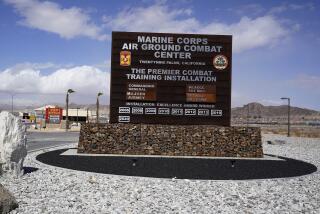Mobile Marines : Units of 60,000-Man Force Could Be on Way in 16 Hours
- Share via
TWENTYNINE PALMS — Under a new, streamlined system developed since the Persian Gulf War, the Marine Corps now could have a fighting force on its way to Iraq or anywhere else in the world within 16 hours, an El Toro general said Monday.
Maj. Gen. Harold W. Blot, commander of the El Toro-based 3rd Marine Air Wing, told reporters during a joint military exercise here that the response time for the first wave of Marines to deploy by plane or ship has been cut to less than a day from the 72 hours it took at the start of Desert Shield in August, 1990.
Blot was among a handful of high-ranking officers participating in Operation Green Hammer at the vast Marine training center at Twentynine Palms. More than 6,000 Marine, Army, Navy and Air Force personnel were playing out a mock war here over hundreds of miles of scorching desert just north of Palm Springs in San Bernardino County. Temperatures reached 110 degrees Monday.
From the air-conditioned Joint Forces Command Center, Blot, 53, said the command structure for quick-response Marine units has been simplified and the brigades that traditionally were the first to ship out have been merged into a larger, 60,000-member Marine Expeditionary Force under the command of one officer, Lt. Gen. Robert B. Johnston.
Units of the Camp Pendleton-based force are specially trained on quick deployment and are ready to go 24 hours a day. They can link up with pre-positioned ships that carry enough supplies to keep them on the battlefield for up to 60 days.
“We learned a lot in the Persian Gulf,” said Blot.
During the exercise, Blot, dressed in battle fatigues, was in charge of coordinating all air power at Twentynine Palms. It was the first time that a Marine has been in charge of a joint force air operation.
Helicopters from Tustin and F/A-18 fighter squadrons are part of the First Marine Expeditionary Force. The air wing provides air cover and moves supplies and personnel for the two divisions that make up the expeditionary force.
Operation Green Hammer began last Friday as world leaders threatened Saddam Hussein with a new round of air attacks if he did not allow United Nations inspectors into the building of the Agriculture Ministry. Iraq has since agreed to let the inspectors enter the building, but many believe that his actions will eventually lead to military action by the United Nations.
“What has been going on in Iraq certainly has us focused on that part of the world,” said Col. Fred Peck of Camp Pendleton. “If we were to engage again in Southwest Asia, the Marine Expeditionary Force under Gen. Johnston would certainly be the first to go.”
Blot said training exercises such as the one under way at Twentynine Palms makes him “more comfortable” with the possibility of future deployments.
“We are set up and trained to go and we are practicing what we have been trained to do,” Blot said.
Troops trained at Twentynine Palms were the first to be shipped to the Persian Gulf in 1990. Although it is not exactly like the Saudi and Kuwaiti deserts, most agree that the San Bernardino desert is pretty close.
“This is like a vacation,” joked Marine Maj. James O’Donnell of Camp Pendleton. “I went to Saudi Arabia in August and was sent to the Saudi-Kuwait border with Saudi troops. It got up to 125 degrees.”
O’Donnell was part of a forward air control team that was positioned on a desert knoll nearly 30 miles from the main base overlooking a desolate valley that appeared to quiver because of the heat waves coming up from the ground.
“No matter what’s going on in the world, we always train very seriously,” said Air Force Capt. Bill Miller, another member of the small group that spent nights and days atop the hill guiding Marine F/A-18s and Air Force A-10s and F-16s to their enemy targets below in the valley.
“But,” Miller continued, “something like the increased tensions in Iraq never hurts an exercise like this--it helps you concentrate.”
Small camps covered with camouflage netting to hide them from air attacks were scattered throughout the desert surrounding Twentynine Palms. The Marine Expeditionary Force headquarters was at the foot of a mountain in sight of the airfield that was overloaded with sleek fighter jets, big and small helicopters and larger C-130 cargo planes.
Blot said the heat and dust in the desert are good training tools. He said soldiers learn which equipment can take the heat, sand and dust, and which cannot. “They learn what has to be air-conditioned and what stops when dust gets in it,” he said.
The mock war played out over the last four days included enemy divisions attacking from the Colorado River and from Yuma, Ariz.


